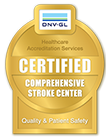Quality, Accreditations, & Patient Satisfaction
Southeast Health is a dynamic, growing organization with a 420-bed hospital, a medical school and clinics throughout the region. It is our vision to be recognized as the healthcare provider of choice, and that means consistently providing a high quality patient care experience for those we serve.
We believe offering high-quality, evidence-based care leads to more lives saved and less time in the hospital. Many factors can be used to compare the quality of care provided by a hospital, these may include:
- Does the hospital monitor and continually strive to improve its quality?
- Does the hospital meet national quality standards?
- Does the hospital meet or exceed quality standards for my condition?
Accreditation is another way to judge quality. Hospitals can choose to be surveyed by a state agency or a CMS approved independent accreditation agency to determine if they meet certain quality standards. When a hospital or hospital service is surveyed, the reviewer evaluates whether the standards they use to measure quality have been met. If a hospital or hospital service meets the specified standards, they are accredited. Southeast Health’s facilities and services are accredited in the following areas:

Hospital Accreditation

Comprehensive Stroke Center

Chest Pain Center

Diagnostic Imaging
Patient Satisfaction scores for Southeast Health
View ScoresHospital Compare
Hospital Compare has information about the quality of care at over 4,000 Medicare certified hospitals across the country. You can use Hospital Compare to find hospitals and compare the quality of their care. The information on Hospital Compare helps you make decisions about where you get your health care. Compare hospitals by clicking here.
The Leapfrog Group
To provide the safest, high-quality care, hospitals must have appropriate policies and technology in place to manage and reduce errors. From the right expertise in an Intensive Care Unit (ICU), to a computerized system for entering prescriptions, to hospital-wide policies designed to protect patients—these are the areas that have the biggest impact on patient outcomes. Compare hospitals by clicking here.
Hospital Safety Score
The Hospital Safety Score uses national performance measures from the Leapfrog Hospital Survey, the Agency for Healthcare Research and Quality (AHRQ), the Centers for Disease Control and Prevention (CDC), the Centers for Medicare and Medicaid Services (CMS), and the American Hospital Association’s Annual Survey and Health Information Technology Supplement. Taken together, those performance measures produce a single score representing a hospital’s overall performance in keeping patients safe from preventable harm and medical errors. The Hospital Safety Score includes 30 measures, all currently in use by national measurement and reporting programs. Compare hospitals by clicking here.
Our top priority is the health, safety and comfort of each and every patient. Our goal is nothing less than to deliver exceptional care with professional expertise and personal attention. Patients and families may express their satisfaction and concerns in a variety of ways.
At Southeast Health, these include:
- Mention any concerns or complaint to a staff member, nurse or nurse supervisor immediately so that the matter can be resolved to your satisfaction.
- If your concerns are still not resolved, patients are encouraged to contact the Patient Speak Up Line at 334-793-8720.
- The individual also has the right to contact one or more of the following agencies:
- The Alabama Department of Public Health by calling 1-800-356-9596 or by mail at P.O. Box 30317, Montgomery, AL 36310.
- DNV GL Healthcare by calling 1-866-496-9647, or by clicking here.
Southeast Health’s mission is to promote healing, prevent disease, educate medicine’s brightest minds, and bring wellness and prosperity to the region. We believe high quality healthcare should be available to everyone who needs it regardless of race, ethnicity, age, gender, sexual orientation, disability, religion, or other factors. Learn more about our efforts to improve the quality of care we provide and create health equity here.
Nursing leaders make every effort to ensure optimal staffing for patient care. In that effort, nursing leaders benchmark quarterly with a nationally recognized nursing database and peer hospitals to set and/or adjust staffing goals. Nurse-to-patient ratios are based on the acuity of illness of the patient as determined by the patient classification system, as well as nursing judgment. The ratios vary from 1 nurse to 1 patient in the critical care setting to 1 nurse to 7-8 patients on night shift on units with stable patients preparing to transition home.
There is an ongoing effort by nursing leaders to assess and analyze staffing needs. Staffing targets are adjusted when changing needs are identified.
Data updated on April 26, 2024


